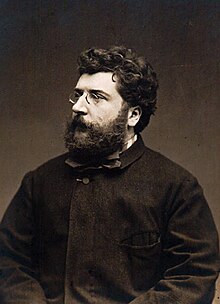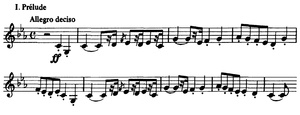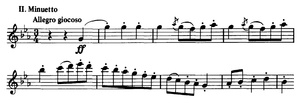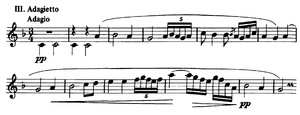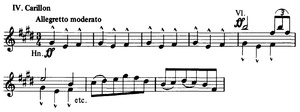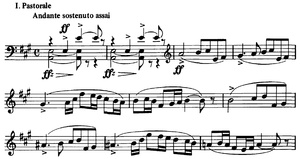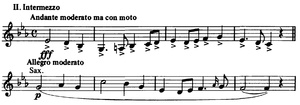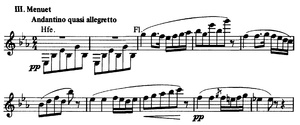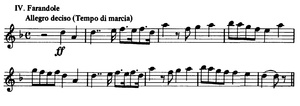L'Arlésienne (Bizet)
L'Arlésienne (German: "Die Arlesierin") by Georges Bizet was originally created in 1872 as incidental music for the play of the same name by Alphonse Daudet and includes orchestral pieces, choirs and melodramas. Daudet's play was unsuccessful, and Bizet's music was recognized by the Parisian audience as extraordinarily successful as soon as it was first performed, so that he put together an orchestral suite from a few pieces that met with great acclaim and that Bizet became popular even before his opera Carmen in Paris made. In today's concert practice, two suites are present, the second suite being put together posthumously by Ernest Guiraud .
Incidental music
In 1872 (three years before his death) Georges Bizet was commissioned to compose incidental music for Alphonse Daudet's tragedy L'Arlésienne . The plot of the three-act play, set in Provence , is devoted to the conflicts of a young farmer (who eventually commits suicide) between two women: a beautiful girl from the city of Arles and a girl from his immediate vicinity who is in love with him.
Bizet's incidental music included a total of 27 mostly short numbers. He had to take into account a small orchestra of only 26 players, to which a choir was added in individual parts. The instrumental line-up, which is unusual especially with regard to the strings, includes 2 flutes , an oboe (also English horn ), 1 clarinet , 2 bassoons , a saxophone in Eb, 2 horns , timpani and tambourine (1 player), 7 violins , 1 viola , 5 cellos , 2 double basses , piano and harmonium (behind the scene, to accompany the choir).
Bizet wrote a separate piece of music that only used passages to a total of three melodies that he had taken from a Provençal collection published in 1864: A Marcho dei Rei (including in the overture), the Danse dei Chivau-Frus (Farandole) and Er dou Guet .
The premiere of L'Arlésienne took place on October 1, 1872 at the Théâtre du Vaudeville in Paris . It proved to be a failure and the piece disappeared from the schedule after three weeks.
Suite No. 1
Irrespective of bad reviews, which also applied to his music, shortly after the premiere, Bizet orchestrated 4 pieces of his incidental music (with individual formal changes) for large orchestra. L'Arlésienne Suite No. 1 was first heard in this form at a concert organized by Jules Pasdeloup in Paris on November 10, 1872. It was enthusiastically received by the audience and was performed several times during Bizet's lifetime.
The suite with a playing time of about 17 minutes provides the following scoring: 2 flutes, 2 oboes (2nd also English horn), 2 clarinets, 2 bassoons, 1 alto saxophone , 4 horns, 2 trumpets , 2 pistons , timpani , snare drum , harp (or piano ) and strings .
Sentence sequence
- I. Prelude (Allegro deciso). In the first part (C minor) of the two-part movement, the marching rhythm of the Provençal Christmas carol Marcho dei Rei ("March of the Kings") dominates - instrumentally and harmonically varied four times , in the second part a serene, melancholy thought intoned by the saxophone (A-flat) Major) and a "love theme" (C major) assigned to the main male character in Daudet's tragedy.
- II. Minuetto (Allegro giocoso). The dance-like movement (C minor) is a mixture of scherzo and waltz trio and is reminiscent of 18th century music.
- III. Adagietto (Adagio). The delicate, soulful movement (F major), which has only 34 bars, is only played by the muted string orchestra.
- IV. Carillon (Allegro moderato). The composition develops over a bell-like ostinato of the horns and the harp (E major), interrupted by a siciliano-like , elegiac episode of the two flutes (C sharp minor).
Suite No. 2
In 1879, four years after Bizet's death, his friend Ernest Guiraud composed the four-movement L'Arlésienne Suite No. 2 . However, it is not just a compilation of Bizetsch music, but in essential parts a new composition by Guiraud, based on themes and passages from incidental music. The premiere took place on March 21, 1880 as part of the Concerts populaires organized by Pasdeloup .
The orchestration of the 2nd suite - the playing time is between 13 and 19 minutes - largely corresponds to Suite No. 1: 2 flutes (2nd also piccolo flute ), 2 oboes, 2 clarinets, 2 bassoons, 1 alto saxophone, 4 horns, 2 Trumpets, 2 pistons, 3 trombones , timpani, percussion (tambourine, bass drum , cymbals ), harp and strings.
Sentence sequence
- I. Pastoral (Andante sostenuto assai). The movement (A major) begins rather melancholy, contrasting insertions with the solo flute, English horn and bassoon as well as the prominent piccolo over the tambourine.
- II. Intermezzo (Andante moderato ma con moto). In the three-part structure of the movement (E flat major), a gloomy, march-like frame theme is juxtaposed with an expressive melody in the saxophone.
- III. Minuet (Andantino quasi allegretto). A duet of harp and flute opens the movement and also determines the further course. The material was taken from Guiraud Bizet's opera La jolie fille de Perth from 1866.
- IV. Farandole (Allegro deciso, Tempo di marcia). The impressive, stormy final movement (C minor / D major) combines the opening theme of the 1st movement of Suite No. 1 with a Farandole , a Provençal folk dance.
Recordings
Both suites are available in numerous recordings. Michel Plasson at EMI and John Eliot Gardiner at Erato have recorded the entire stage music . The entire stage work with full text and all musical numbers by Bizet was recorded for the Decca label in the 1950s under the direction of Albert Wolff . Another complete recording was made in the French original at the Festival of Sion (CH) for the Swiss label Gallo. In 1997, WDR Cologne produced L'Arlésienne as a concert radio play in a German version by Christoph Schwandt with Gert Westphal , conducted by Helmuth Froschauer .
See also
literature
- Winton Dean: Georges Bizet. Life and work . DVA, Stuttgart 1988, ISBN 3-421-06385-0 , p. 266 ff.
- Wulf Konold (Ed.): Lexicon Orchestermusik Romantik. AH . Piper / Schott, Mainz 1989, ISBN 3-7957-8226-0 , pp. 54-57.
- Hans Renner, Klaus Schweizer: Reclam's concert guide for orchestral music . 10th edition. Philipp Reclam jun., Stuttgart 1976, ISBN 3-15-007720-6 , pp. 368-370.
- Hans Jürgen Schaefer (ed.): Concert book orchestral music A-F . VEB Deutscher Verlag für Musik, Leipzig 1979, pp. 249-251.
- Christoph Schwandt : Georges Bizet. A biography. Schott, Mainz 2011, ISBN 978-3-254-08418-7 .
Individual evidence
Web links
- L'Arlésienne : Sheet music and audio files in the International Music Score Library Project
